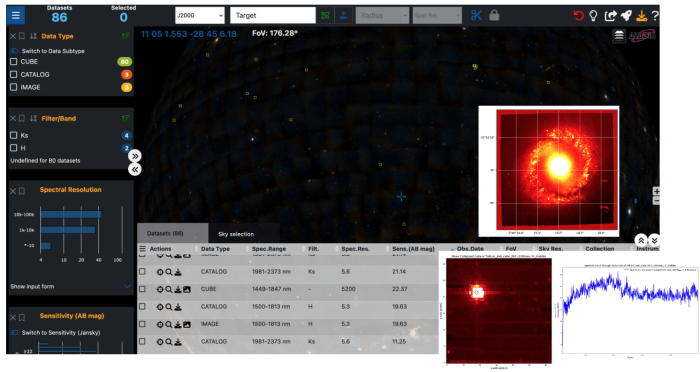The Enhanced Resolution Imager and Spectrograph (ERIS) is a general-use infrared integral field spectrograph and imager that utilises the adaptive optics on the VLT’s UT4. After one year of operation, the proprietary period for the first observations has expired. Both raw and fully processed science data are now publicly available for download via the ESO Archive. The processed data are organised into two data collections, ERIS-NIX and ERIS-SPIFFIER, which contain reduced scientific imaging products and 3D data cubes, respectively.
First ERIS Imaging and IFU Data Become Public

ERIS-NIX: The imager operates in the near-infrared range of 1 – 5 μm (J to Mp bands) and is designed to provide diffraction limited imaging. Data from the ERIS/NIX imager with the 13 or 27mas/pixel cameras (field-of-view of 27”x27” and 55”x55”) are fully processed. For other modes and data formats offered by NIX (coronagraphy, very short exposure “burst” mode cubes, and long-slit spectroscopy) only the raw data are available at this time.
The NIX data provided consists of science exposures that have been dark-corrected, flat-fielded, linearity and gain corrected, sky background corrected, and astrometrically and photometrically calibrated. The processed data provided consists of combined (stacked), resampled exposures, their associated single-band source detection catalogues, and the individual exposures that make up the stacked images. Each of these science frames is provided as a multi-extension fits file, consisting of data, background, errors and quality maps.
The reduced images and related products are available from the ESO Science Archive Facility, either from the web-based interactive Science Portal or via Table Access Protocol, along with comprehensive data release documentation. The DOI assigned to the ERIS-NIX data collection is 10.18727/archive/90.
ERIS-SPIFFIER: The spectrograph is a medium-resolution integral field spectrograph that operates in the near-infrared range of 1 – 2.5 μm (J, H, and K bands). SPIFFIER has twelve grating configurations. Three low-resolution (R~5,000) grating configurations span each of the J, H, and K bands. The nine high-resolution (R~10,000) configurations span each of these bands in sets of three, with each grating spanning approximately one half of the band (one covering the first half, one covering the second half, and one centred on the middle of the band). Three plate scales correspond to an on-sky field-of-view of 0.8" x 0.8", 3.2" x 3.2", and 8" x 8", with corresponding spaxel (spatial pixels) of sizes 12.5 x 25, 50 x 100, and 125 x 250 mas/spaxel, respectively. SPIFFIER can be operated without adaptive optics (AO), with natural guide star AO, and/or with a single laser guide star.
Fully processed data are available for all modes of the spectrograph. The released data consist of science exposures that have been dark-corrected, flat-fielded, wavelength calibrated, sky background corrected and, if possible, photometrically calibrated. The reconstructed 3D combined cube constitutes the primary data product and is provided as a multi-extension file (MEF) consisting of the data, error and quality cubes. The fully processed, individual 3D cubes that make up each combined cube are also included, along with the mean collapsed combined cube (white light), the associated sky exposure cube, and the exposure map.
The reduced science cubes and associated data products are available from the ESO Science Archive Facility, either from the web-based interactive Science Portal or via Table Access Protocol, along with comprehensive data release documentation. The DOI assigned to the ERIS-SPIFFIER data collection is10.18727/archive/91.
